
Exploring anamorphosis: revealing hidden images with mirrors
Through the looking glass: unlock the secrets of anamorphosis, where art and science meet to create mind-bending illusions!

This article was adapted from an ESO blog post.
Seeing is believing, but how can you be sure that what you see is real? Find out how to distinguish between real and fake astronomical images.
We’ve all been there: we see a stunning astrophotography image that has gone viral on social media, showing perhaps a huge full Moon aligned with some landmark or the Milky Way arching in the sky above some exotic location. But then we start second-guessing ourselves – something doesn’t look quite right, yet we can’t put our finger on it. Image manipulation was already commonplace before the advent of artificial intelligence (AI), which is now flooding the internet with fake images at an alarming pace.[1] Ironically, AI is now being used to identify these fake images. We will teach you how to spot some of the most common mistakes in manipulated photographs of the night sky by comparing them with real pictures from true astrophotography pros. Since permission from the artist is also needed for the use of fake images, we created our own fake images and linked to the online images that served as inspiration.
This may surprise you, but the apparent size of the Sun and the Moon in the sky is much smaller than you think: you can easily cover them with a finger held at arm’s length, with room to spare. And yet, astrophotographers often capture stunning images like the ones below, which show the Sun and the Moon rising behind ESO’s Extremely Large Telescope (ELT), which is currently under construction in Chile. These are genuine single photographs, captured in one shot on location, but how are they possible?

Here’s the trick: the apparent sizes of the Sun and the Moon when viewed from Earth are the same. Firstly, they are so far away from Earth that changing your location only makes a small difference to the total distance, so no matter where you are on Earth, they will always appear to be the same size in the sky. Secondly, although the Sun is about 400 times wider than the Moon, it’s also about 400 times farther away, so by coincidence they appear the same size when viewed from the Earth.

Mathematically speaking (using the intercept theorem), for objects of a given apparent size, the ratio of the distance d of the object from the observer to the size S (i.e. diameter) of the object is a constant. In the case of the Sun and the Moon, the ratio is approximately 100:
| Sun | Moon | Object (e.g., tree) | |
|---|---|---|---|
| Distance d in km | 1.5 x 108 | 3.8 x 105 | d |
| Size S in km | 1.4 x 106 | 3.5 x 103 | S |
| Ratio d : S | ≈ 100 | ≈ 100 | ≈ 100 |
Unlike very distant objects like the Sun and the Moon, nearby objects like buildings or trees appear smaller the further you are from them. So if you move far away enough, these objects can end up appearing as small as the Sun or the Moon; all you need then is a telephoto lens or a small telescope to zoom in and amplify the image.
Based the ratio shown in the table above, an object of size S will have roughly the same apparent size as the Sun/Moon when seen from a distance of 100 × S. So, if a photograph contains a foreground object with a known size, then you can work out how far away the photographer had to be to take that shot and hopefully conclude whether the image is genuine or not.
Let’s put this to the test with the ELT images above. The ELT dome[2] is 88 m wide, and the Sun/Moon appear to be a bit more than twice as wide: about 200 m. If the Sun/Moon appears to have the same size as a 200 m object, then the object needs to be 100 x 200 m = 20 km away. That’s indeed the distance between Cerro Armazones, where the ELT is located, and ESO’s Paranal Observatory, from where these images were taken.
Now take a look at photographs featuring the full Moon behind Big Ben in London. You can stack about six imaged Moons on top of each other along the tower of Big Ben, which is 96 m tall.[3] So, the apparent diameter of the imaged Moon is about 16 m, meaning that the photographer had to be 1.6 km away to get this shot. However, it is clear from the framing of the image that it was taken somewhere on the other bank of the Thames, which is only 200–300 m away from Big Ben.
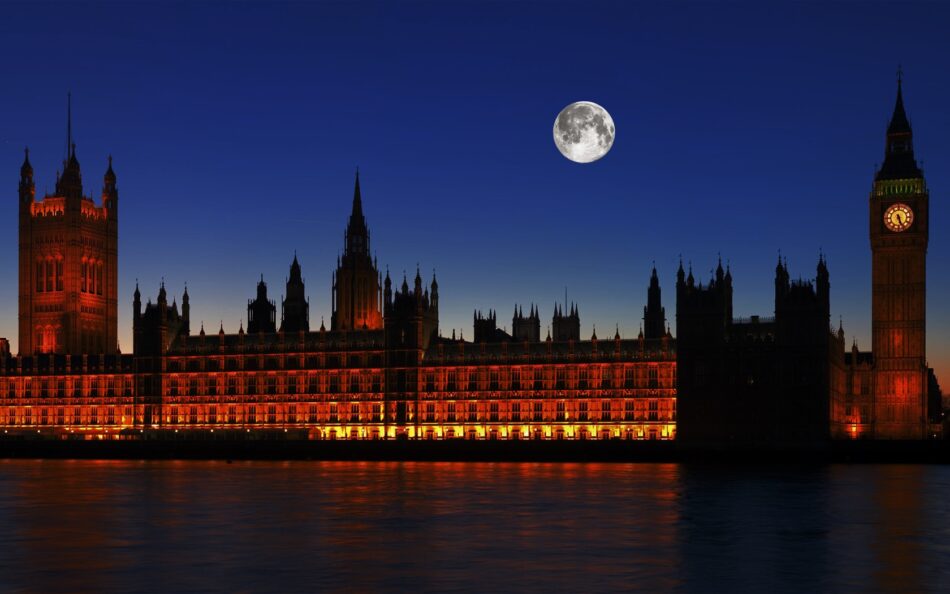
Something else to watch out for in this kind of image is whether the Sun or Moon look too sharp. When they are close to the horizon, their light goes through a big chunk of Earth’s atmosphere, which blurs and even squashes the images.[4] But if the Sun or Moon look perfectly crisp, like in the above image, that’s often a telltale sign that they were added in.
Even in the absence of terrestrial landmarks, it is often possible to spot when the Sun or Moon have been artificially added by comparing them with other celestial objects. For example, observe the image to the left below, which is similar to one often shared on social media as an actual photograph of a solar eclipse seen from space. It is in fact a computer-generated image. One of the giveaways is that the Sun and Moon are nowhere near as big compared to the Milky Way, which you can see just below the “eclipsed Sun” in the image. Compare it with a real photograph (right) showing the Milky Way in the sky with the moon, taken at the Atacama Large Millimeter/submillimeter Array (ALMA).
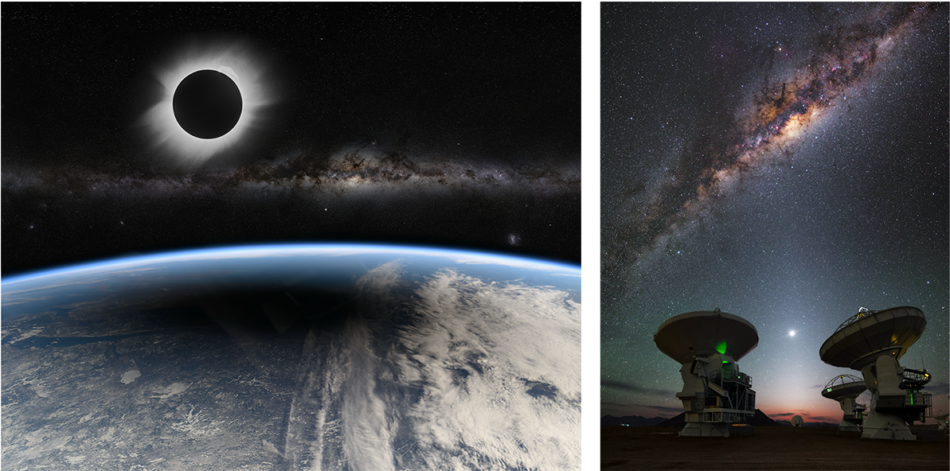
What about the left image below? The Sun and Moon, beautifully framed by palm trees, don’t look impossibly large. Could this be a real shot? Look closer: the Moon is fully illuminated, which can only happen if the Sun is directly behind the camera, not in front of it. It is possible to see the Moon close in the sky to the Sun, but it looks like a crescent, with the bright side pointing to where the Sun is, as in the photograph on the right taken at ESO’s Paranal Observatory.
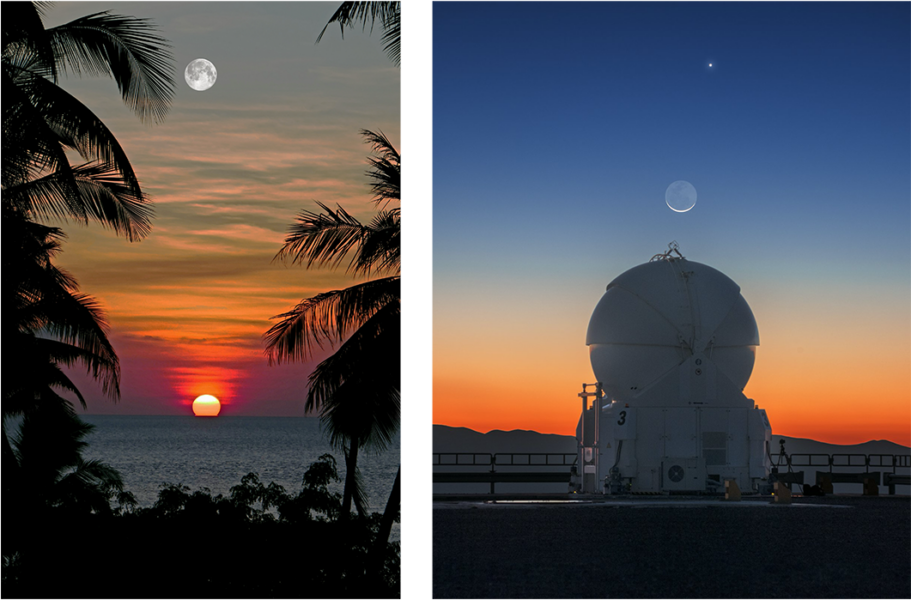
The Milky Way, our home galaxy, is another recurrent subject in fake astronomical images, and the image below is a textbook example. It is similar to one that is often shared on social media, which purportedly shows the Milky Way perfectly aligned with the temple of Karnak in Egypt. This photograph is a bingo of every mistake you could possibly make when faking an astronomical image.
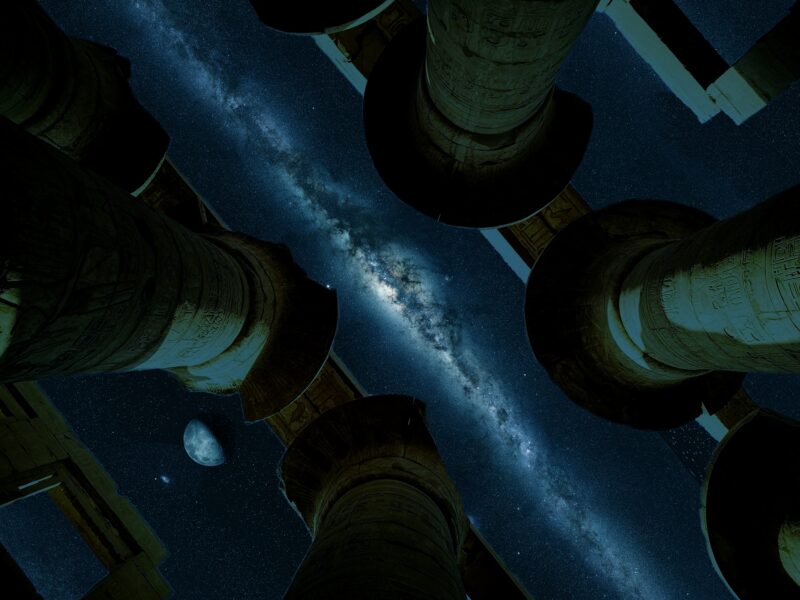
Firstly – yes, you guessed it – the Moon is ludicrously large (and also transparent if you look closely…).
Secondly, the brightest part of the Milky Way never crosses the sky directly overhead at Karnak. Our galaxy is a swarm of billions of stars arranged in a flat disc and a dense bright centre, similar to a fried egg. We’re located in the outskirts of the disc, and due to the way the Earth is oriented in space, the centre of the Milky Way appears higher up in the sky in the southern hemisphere than in the northern one. More precisely, the centre can only be seen directly overhead from locations at a latitude of around 29° south, as seen in this image taken from ESO’s La Silla Observatory.
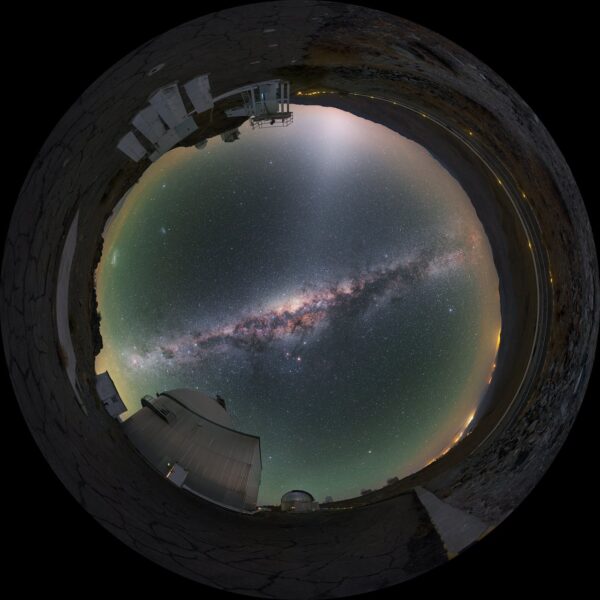
At Karnak, at a latitude 26° north, the Milky Way centre never rises higher than 35° above the horizon. And the further north you travel, the lower the centre will be. Northward of latitudes of around 60° north, the Milky Way’s centre is always below the horizon. So if you ever see an image of the Milky Way centre from, say, Finland, you know it’s not a real image.
But wait, we’re not done with Karnak yet! Do you see that faint smudge to the bottom-left of the Moon? That’s the Small Magellanic Cloud, one of two dwarf galaxies orbiting our own Milky Way. These galaxies are very close to the south celestial pole, and they can’t be seen at all from Karnak: they are pretty much an exclusive perk of the southern hemisphere.
We’ve only scratched the surface of the most common mistakes in fake astrophotography images. It requires a lot of practice and a good understanding of the sky to spot these inaccuracies, a task that can often seem daunting. Luckily, there are many software tools at our disposal to simplify this job.
Reverse image search is an essential tool when fact-checking photographs, astronomical or otherwise. Uploading an image to TinEye or Google Images yields a list of matches that you can then sort by different criteria, such as date, match quality, web domain, etc. For example, doing a reverse image search of the Big Ben image we discussed earlier leads us to the original image without the Moon.
Stellarium, a free and open-source planetarium software, is another must-have. It allows you to visualize the sky from any location, at any given date and time. Photopills and The Photographer’s Ephemeris are invaluable tools to figure out if and when the Sun or the Moon can be aligned with terrestrial landmarks, and how big they will look in comparison.
Sometimes, however, the fastest route is just to check whether someone has investigated an image before. Websites and social media accounts like Snopes, Fake Astropix and PicPedant are very reputable sources that debunk photo manipulation in great detail, including AI-generated images.
Altered astronomical images, whether it is for legitimate artistic reasons, click-bait purposes, or just for fun, are part of our online lives. We hope this brief primer on astrophotography forensics has set you on your way to becoming an image sleuth!
[1] Article on AI-generated images: https://journal.everypixel.com/ai-image-statistics
[2] Info on the ELT Dome: https://elt.eso.org/telescope/dome/
[3] Facts and figures on Big Ben: https://www.parliament.uk/about/living-heritage/building/palace/big-ben/facts-figures/
[4] Article on the refractive power of Earth’s atmosphere: https://skyandtelescope.org/astronomy-news/find-a-horizon-and-savor-the-bending-of-light/

Through the looking glass: unlock the secrets of anamorphosis, where art and science meet to create mind-bending illusions!
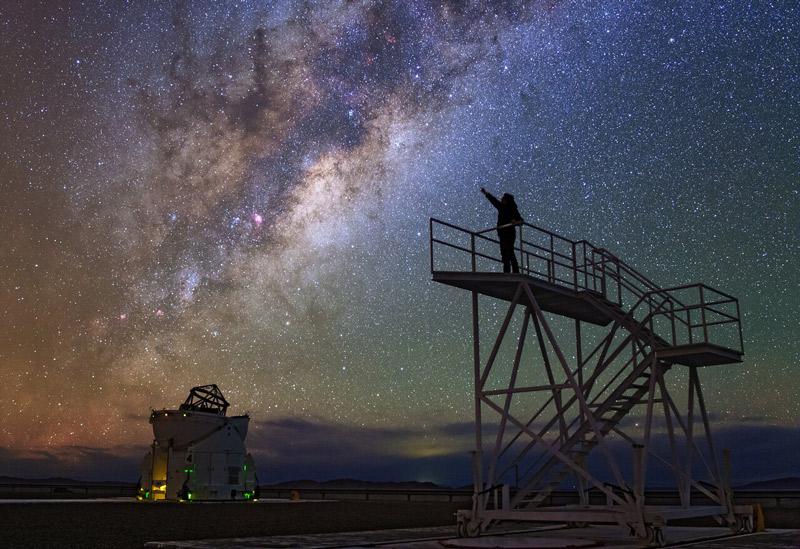
We can’t image our home galaxy from the outside, so how do we study it? Learn how astronomers unveil the dramatic past of the Milky Way and peer into its future.
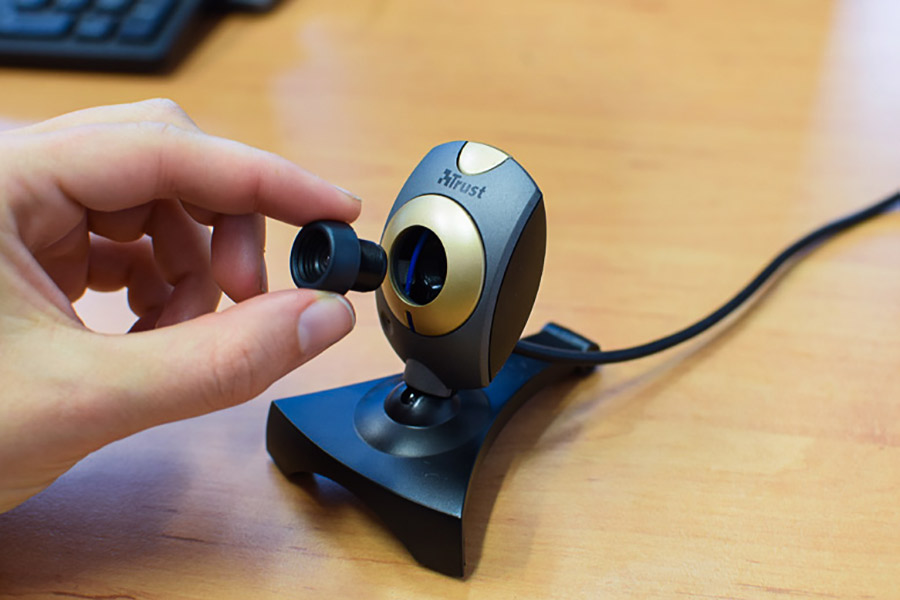
What would the world look like if we could see infrared light? With some simple modifications, you can turn a cheap webcam into an infrared camera…